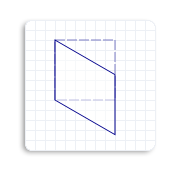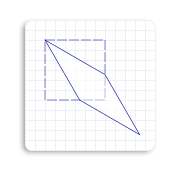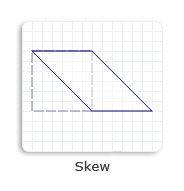Note
Access to this page requires authorization. You can try signing in or changing directories.
Access to this page requires authorization. You can try changing directories.
To skew (or shear) an object means to distort an object by a specified angle from the x-axis, the y-axis, or both. For example, when you skew a square, it becomes a parallelogram.
The Matrix3x2F::Skew method takes 3 parameters:
- angleX: The x-axis skew angle, which is measured in degrees counterclockwise from the y-axis.
- angleY: The y-axis skew angle, which is measured in degrees clockwise from the x-axis.
- centerPoint: The point about which the skew is performed.
To predict the effect of a skew transformation, consider that angleX is the skew angle measured in degrees counterclockwise from the y-axis. For example, if angleX is set to 30, the object skews 30 degrees counterclockwise along the y-axis about the centerPoint. The following illustration shows a square skewed horizontally 30 degrees about the upper-left corner of the square.

Similarly, angleY is a skew angle measured in degrees clockwise from the x-axis. For example, if angleY is set to 30, the object skews 30 degrees clockwise along the x-axis about the centerPoint. The following illustration shows a square skewed vertically 30 degrees about the upper-left corner of the square.

If you set both angleX and angleY to 30 degrees, and the centerPoint to the upper-left corner of the square, you will see the following skewed square (solid outlined). Notice that the skewed square is skewed 30 degrees counterclockwise from the y-axis and 30 degrees clockwise from the x-axis.

The following code example skews the square 45 degrees horizontally about the upper-left corner of the square.
// Create a rectangle.
D2D1_RECT_F rectangle = D2D1::Rect(126.0f, 301.5f, 186.0f, 361.5f);
// Draw the outline of the rectangle.
m_pRenderTarget->DrawRectangle(
rectangle,
m_pOriginalShapeBrush,
1.0f,
m_pStrokeStyleDash
);
// Apply the skew transform to the render target.
m_pRenderTarget->SetTransform(
D2D1::Matrix3x2F::Skew(
45.0f,
0.0f,
D2D1::Point2F(126.0f, 301.5f))
);
// Paint the interior of the rectangle.
m_pRenderTarget->FillRectangle(rectangle, m_pFillBrush);
// Draw the outline of the rectangle.
m_pRenderTarget->DrawRectangle(rectangle, m_pTransformedShapeBrush);
The following illustration shows the effect of applying the skew transformation to the square, where the original square is a dotted outline and the skewed object (parallelogram) is a solid outline. Notice that the skew angle is 45 degrees counterclockwise from the y-axis.

Related topics